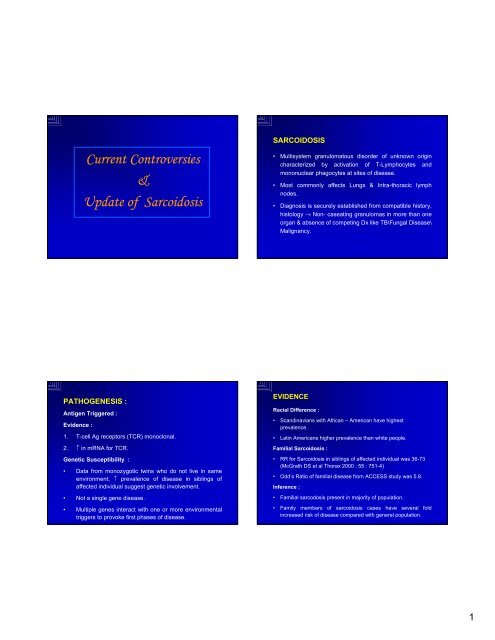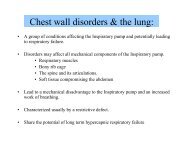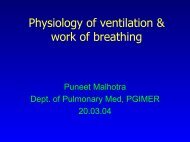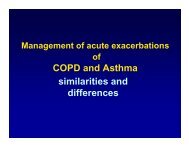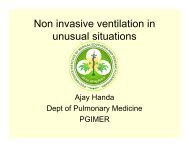Current Controversies & Update of Sarcoidosis
Current Controversies & Update of Sarcoidosis
Current Controversies & Update of Sarcoidosis
You also want an ePaper? Increase the reach of your titles
YUMPU automatically turns print PDFs into web optimized ePapers that Google loves.
<strong>Current</strong> <strong>Controversies</strong><br />
&<br />
<strong>Update</strong> <strong>of</strong> <strong>Sarcoidosis</strong><br />
PATHOGENESIS :<br />
Antigen Triggered :<br />
Evidence :<br />
1. T-cell Ag receptors (TCR) monoclonal.<br />
2. ↑ in mRNA for TCR.<br />
Genetic Susceptibility :<br />
• Data from monozygotic twins who do not live in same<br />
environment, ↑ prevalence <strong>of</strong> disease in siblings <strong>of</strong><br />
affected individual suggest genetic involvement.<br />
• Not a single gene disease.<br />
• Multiple genes interact with one or more environmental<br />
triggers to provoke first phases <strong>of</strong> disease.<br />
SARCOIDOSIS<br />
• Multisystem granulomatous disorder <strong>of</strong> unknown origin<br />
characterized by activation <strong>of</strong> T-Lymphocytes and<br />
mononuclear phagocytes at sites <strong>of</strong> disease.<br />
• Most commonly affects Lungs & Intra-thoracic lymph<br />
nodes.<br />
• Diagnosis is securely established from compatible history,<br />
histology → Non- caseating granulomas in more than one<br />
organ & absence <strong>of</strong> competing Dx like TB\Fungal Disease\<br />
Malignancy.<br />
EVIDENCE<br />
Racial Difference :<br />
• Scandinavians with African – American have highest<br />
prevalence.<br />
• Latin Americans higher prevalence than white people.<br />
Familial <strong>Sarcoidosis</strong> :<br />
• RR for <strong>Sarcoidosis</strong> in siblings <strong>of</strong> affected individual was 36-73<br />
(McGrath DS et al Thorax 2000 ; 55 : 751-4)<br />
• Odd’s Ratio <strong>of</strong> familial disease from ACCESS study was 5.8.<br />
Inference :<br />
• Familial sarcodosis present in majority <strong>of</strong> population.<br />
• Family members <strong>of</strong> sarcoidosis cases have several fold<br />
increased risk <strong>of</strong> disease compared with general population.<br />
1
Key Candidate Genes :<br />
MHC → HLA class I bind endogenous antigen<br />
↓ peptides and present than to CD8 + cells.<br />
HLA Class II bind peptides from exogenous antigens & present<br />
them to CD4 + cells.<br />
MHC Class I :<br />
HLA B7 ass. with high prevalence <strong>of</strong> sarcodosis in African-<br />
Americans, HLA B8 ass. With ac. Onset and short duration.<br />
MHC class II :<br />
Japanese pts. : HLA DR5, -DR8, -DR9 alleles<br />
Germans : HLA-DR5 ass. With chr. Disease<br />
DR3 ass. With acute disease.<br />
Scandinavian study : HLA-DR3 → ac. onset and short duration.<br />
HLA-DR 14, DR 15 chr. Disease.<br />
2. Clustering :<br />
• Hill SE (Thorax 1987 : 42 : 427-30) noted time space<br />
clustering.<br />
• Cases whose place <strong>of</strong> residence during an infective period<br />
<strong>of</strong> 5 yrs. Before and 2 yrs. After the DX were separated by<br />
distance <strong>of</strong>
) Anti-Mycobacterial Ab. Study :<br />
Chapman et al → ppt. Ab. To atypical mycobacteria in<br />
78% <strong>of</strong> sarcoid pts.<br />
c) Molecular Studies :<br />
PCR based studies : MTB found in
SUMMARY<br />
1. Evidence for a microbial trigger for sarcodosis is not<br />
unequivocal.<br />
2. Propionobacteria ass. is the most attractive but putative<br />
mycobacterial ass. is persistent.<br />
3. No single agent stands out with certainty.<br />
4. Microbial involvement has been shown in disease as<br />
diverse as peptic ulcer disease, CAD, there is a<br />
possibility that microbes are an important triggers to<br />
sarcodosis that falls well short <strong>of</strong> infection.<br />
↓<br />
IL-2, IFN-γ, IL-16<br />
• ↑ IL-2 levels in lymphocytic alveolitis ass. with poor<br />
·<br />
prognosis.<br />
Activated T-cells ass. with ↑ sIL-2 receptor (sIL-2R)<br />
ALVEOLAR MACROPHAGES :<br />
• ↑ in no. <strong>of</strong> activated alveolar macrophages.<br />
· Release cytokines : IL-1, TNF−α, MIP-1α, MCP-1, IL-8,<br />
IL-12, IL-18.<br />
· Poor prognosis and disease activity :<br />
i) IL-8 (potent neutrophil chemotactic factor)<br />
↓<br />
↑ no. <strong>of</strong> neutrophils.<br />
T cells :<br />
• ↑ in No. esp. CD4 + cells.<br />
• CD4 + - 2 functional subsets.<br />
TH1 Cells TH2 Cells<br />
↓ ↓<br />
CMI Humoral Immunity<br />
In sarcoidosis, T Cells release TH1 cytokines<br />
• Alveolar macrophages<br />
↓<br />
IL –12<br />
↓<br />
T-cells + to release TH1 and cytokines<br />
Neutrophilic alveolitis reflects ongoing inflammation ass<br />
with disease progression.<br />
ii) MIP – 1α, MCP-1 ass. with ongoing inflammation.<br />
iii) IL-12 indicates poor prognosis.<br />
iv) IL-18 induces release <strong>of</strong> IFN- γ from T-Cells results in<br />
further stimulation <strong>of</strong> macrophages and cytotoxic Tcells.<br />
v) TGF-β ass. with spontaneous resolution.<br />
4
ROLE OF TNF-α IN SARCOIDOSIS<br />
• TNF α : Higher in active disease.<br />
• TNF α binds to 2 kinds <strong>of</strong> receptors : TNF RI and TNF R II.<br />
• Soluble forms <strong>of</strong> these receptors ↑ in RA/ Crohn’s disease and<br />
Malignancies .<br />
• sTNF R II – Imp. Parameters <strong>of</strong> disease activity in serum and<br />
BAL fluid.<br />
• ↑ TNF α → in asymptomatic disease : higher<br />
(In BAL fluid) risk <strong>of</strong> disease progression.<br />
Symptomatic disease : Higher rate <strong>of</strong> relapse.<br />
BASIC SCIENCE ‘FACTS’ OF SARCOIDOSIS<br />
• <strong>Sarcoidosis</strong> : Granuloma with fibrinoid necrosis, rarely<br />
caseation.<br />
• Sites <strong>of</strong> inflammation have activated T-cells and mononuclear<br />
phagocytes.<br />
• These cell express pro-inflammatory cytokines &<br />
chemokines which are critical in granuloma formation and<br />
CMI.<br />
• Ass. with dominant, polarized Th-1 immune response.<br />
• Granulomatous inflammation is ass. with oligoclonal T-cell<br />
population.<br />
Chr. Sarcoid pts. with ↑ TNF-α do not respond to steroids.<br />
Reasons :<br />
TNF-α ↓ sensitivity <strong>of</strong> monocytes to dexamethasone.<br />
↓<br />
Corticosteroid resistance<br />
<strong>Sarcoidosis</strong> as TH-1 disorder :<br />
• Dominant TH-1 disorder.<br />
• IF- γ, IL-12, IL-18 (γ-IFN enhancing factor) levels<br />
increased.<br />
EVIDENCE :<br />
• Pathogenesis <strong>of</strong> sarcoidosis may involve TH-1 promoting<br />
infectious<br />
organisms).<br />
agents (mycobacterial/ propionobacterial<br />
• <strong>Sarcoidosis</strong> is induced/relapses with use <strong>of</strong> TH-1<br />
promoting biological response modifers such as IFN-α,<br />
IL-2 therapy.<br />
5
TREATMENT OF SARCODOSIS<br />
A) General Principles From Clinical Observations :<br />
1. Granuloma formation dictates clinical course and<br />
therapeutic response.<br />
↓<br />
Therefore suppression <strong>of</strong> granuloma formation results in<br />
preservation <strong>of</strong> organ function and minimize long term<br />
fibrotic outcomes.<br />
2. Corticosteroids : Effective in suppressing granuloma<br />
formation over both short term and long term. Non<br />
corticosteroid therapy variably effective.<br />
STRATEGIES FOR TREATMENT OF SARCOIDOSIS<br />
BASED ON STAGES OF INFLAMMATION IN<br />
DISEASE<br />
Step 1 : Inhibit Ag Presentation<br />
(Anti-Malarial Drugs)<br />
Step 2 : Suppress Granuloma Formation<br />
(Corticosteroids, Immnosuppressives, Anti<br />
TNF agents)<br />
Step 3 : Enhance Ag Clearance<br />
? Peptide based therapy (future)<br />
Step 4 : Inhibit Fibrosis<br />
(Corticosteroids, Immnosuppressives, Anti<br />
TNF agents)<br />
3. Threshold level <strong>of</strong> drug effect for most pts.<br />
→ Below which : Progression <strong>of</strong> granuloma<br />
→ Above which : Suppression <strong>of</strong> granuloma<br />
4. Kinetic <strong>of</strong> granuloma formation variable :<br />
Some progress slowly<br />
Some rapid progression<br />
↓<br />
Organ dysfunction<br />
5. Different tissues respond differently to drugs.<br />
Antimalarials – effective in skin & mucosal disease (Nasal<br />
sinus, URT) than pulmonary disease.<br />
1. Treatment to suppress initiation <strong>of</strong> granuloma<br />
formation :<br />
Strategies :<br />
1. Reduce Ag deposition<br />
2. Enhance Ag clearance<br />
3. (-) Ag processing and presentation<br />
1. Reduce Ag deposition : Antibiotic therapy<br />
• Doxycycline, Minocycline → Effective against<br />
propinobacteria.<br />
• Dapsone, Cl<strong>of</strong>azimine → Anti mycobacterial effects.<br />
• Beneficial in subset <strong>of</strong> sarcoidosis pts.<br />
6
• However, these agents have anti-inflammatory effects.<br />
• Effective in only few anedotal cases<br />
2. Anti-Malarial Drugs Choroquin/Hydroxy Chloroquin :<br />
MoA : (-) Degradation <strong>of</strong> proteins by acid hydrolases within<br />
lysosomes.<br />
(-) MHC – peptide complexes.<br />
Net effect :(-) Ag presentation to T-cells.<br />
II. Treatment <strong>of</strong> Progressive granulomatous<br />
inflammation :<br />
1. Corticosteroids : Broad spectrum anti-inflammatory<br />
effects on multiple cells – Tcells/macrophages/granulocytes.<br />
b) (-) T-cell and B-cell proliferation and cytotoxic T-cell<br />
function.<br />
Toxicities : BM suppression<br />
: GI S/E<br />
: Hepatitis<br />
: Oncogenic effects<br />
Use : Reserved for progressive organ threatening<br />
disease not responding to safer alternatives.<br />
3) Methotrexate :<br />
MoA : Folic acid analogue that (–)<br />
dihydr<strong>of</strong>olate reductase and<br />
transmethylation reactions.<br />
(-) Expression <strong>of</strong> pro-inflammatory cytokines such as<br />
IL-1, IL-2, IL-3, IL-4, IL-5, IL-6, IL-8, IL-11, IL-12, IL-19,<br />
IFN-α & TNF.<br />
(-) Arachadonic acid metabolism :<br />
overall - ↓ cell activation<br />
2) Azathioprine :<br />
MoA : (a) Azathioprine<br />
- Enhanced apoptosis <strong>of</strong> activated T-cells.<br />
Thiopurine –S-methyltransferase<br />
6-Mercaptopurine.<br />
Accumulation <strong>of</strong> 6 –thioguanine nucleotides in target<br />
organs → Imp. Mediator <strong>of</strong> immuno suppression.<br />
Net effect : Interfere with purine metabolism and<br />
polyamine synthesis.<br />
High doses : Anti-Proliferative.<br />
Low doses : Anti-Inflammatory (due to ↑ release <strong>of</strong><br />
adenosine)<br />
↓<br />
(-) TNF, IL-6, IL-8<br />
(-) Release <strong>of</strong> ROI<br />
(-) Lymphocyte proliferation<br />
Toxicity : Hepatic, BM, Pulmonary.<br />
Use : Maintenance treatment <strong>of</strong> serious organ threatening<br />
disease.<br />
7
4. Cyclosporin : T-cell (-)<br />
T-cell activation → 2 signals → TCR complex<br />
↓<br />
Costimulatory molecules CD 28, CD40 on T cell<br />
surface.<br />
These drugs block signal 1.<br />
↓<br />
IL-2 (-)<br />
• However, cyclosporin not very effective.<br />
• Toxicity : Renal, malignancy.<br />
• Use : Serious cases failing more standard therapies.<br />
• Efficacy : 0-80%<br />
b) Thalidomide :<br />
(-) TNF production by mononuclear cells.<br />
- Use : Skin/Mucosal sarcoidosis.<br />
- Toxicity : Teratogenic<br />
- Peripharal Neuropathy<br />
- Sedation<br />
c) Etanercept : Biologic dimeric fusion protein which binds<br />
to TNF and related protein lymphotoxin α<br />
- Toxicities : 1. Infections risk ↑<br />
2. Lupus syndr.<br />
3. Demyelinating disease.<br />
5. TNF Inhibition : TNF plays critical role in granuloma<br />
formation.<br />
a) Pentoxifylline : Methylxanthine derivative :<br />
- Non-selective phosphodiesterase (-)<br />
- (-) TNF production by mononuclear cells including<br />
alveolar macrophages.<br />
- May have a limited role because it is difficult to achieve<br />
therapeutic doses due to frequent GI S/E.<br />
- Dose : 400 mg TDS<br />
- Efficacy : 50-70%<br />
d) Infliximab :<br />
- Humanized monoclonal ab. formed <strong>of</strong> human IgG1 Ab +<br />
protein segments from mouse monoclonal Ab against<br />
human TNF.<br />
- MoA : Block TNF.<br />
- Limitation : Development <strong>of</strong> Anti-murine Ab. Which ↓ its<br />
actions.<br />
- Requires concomitant therapy with methotrexate to<br />
suppress this humoral response.<br />
- ↑ risk <strong>of</strong> recrudescent TB.<br />
- Allergic reaction to chimeric Ab.<br />
- Use : Steroid resistant disease (Anecdotal reports)<br />
8
• None <strong>of</strong> these drugs classified as TNF (-) have been<br />
shown to be effective in sarcoidosis by rigorous study.<br />
• All these have high cost.<br />
• Notable toxicities.<br />
TREATMENT OF PROGRESSIVE<br />
PULMONARY FIBROSIS<br />
- Persistent granulomatous inflammation<br />
↓<br />
Fibrosis<br />
- Probably, there is a switch to Th-2 response in late stages<br />
resulting in elaboration <strong>of</strong> pro-fibrotic cytokines like IL-4.<br />
- No data to support Anti-fibrotic agents such as<br />
-<br />
colchicine/perfenidone in fibrocystic sarcoidosis.<br />
Anti-fibrotic biologic agents : IFN<br />
↓<br />
ass. with relapse <strong>of</strong> sarcoidosis<br />
- For now, anti-inflammatory drug therapy that (-) granuloma<br />
formation → retard/prevent progressive fibrosis.<br />
DIFFERENT STRATEGIES FOR DIFFERENT<br />
STAGES OF SARCOIDOSIS<br />
ROLE OF TH-1 RESPONSE :<br />
Early Stages :<br />
Th-1 driven granulomatous response effective in<br />
clearing granuloma inducing Ag.<br />
Chronic <strong>Sarcoidosis</strong> :<br />
Ongoing Th-1 immune response results in impaired<br />
organ function.<br />
Therefore,<br />
1. Minimize immuno suppression early in disease.<br />
2. In chronic stages focus should be on minimizing<br />
granulomatous inflammation.<br />
FUTURE DIRECTIONS :<br />
1. Identify tissue Ag so that effective action can be taken<br />
against them.<br />
2. Suppress granuloma : Less toxic more targeted<br />
approach.<br />
3. Regulating T-cell response by targeting MHC/Ag/TCR<br />
complex and downstream pathways. Drug blocking<br />
T-cell costimulatory pathway may induce T-cell anergy<br />
or tolerance. (Rapamycin, mycophenolate m<strong>of</strong>etil).<br />
4. (-) Pro inflammatory cytokines like TNF<br />
↓<br />
Limits immunopathology esp. In chr. <strong>Sarcoidosis</strong>.<br />
9
5. Enhance anti-inflammatory cytokines like IL-10.<br />
Overall Goal : Suppress granuloma<br />
↓<br />
Limit tissue injury and fibrosis in pts.<br />
demonstrating progressive organ dysfunction.<br />
Corticosteroid therapy in pulmonary sarcoidosis.<br />
(Paramothayan. S, Jones PW JAMA 2002; 287: 1301-<br />
1307).<br />
• Analysis <strong>of</strong> 8 RCT <strong>of</strong> the role <strong>of</strong> steroids oral/inhaled or<br />
both in outcome <strong>of</strong> sarcoidosis.<br />
• Treatment <strong>of</strong> pulmonary sarcoidosis with oral steroids for<br />
a period <strong>of</strong> 6-24 mths. improved CXR findings.<br />
• Pts. not Treatment with steroids had more chances <strong>of</strong><br />
deterioration compared with those receiving prednisolone.<br />
• In one study, Israel HL et al (Am Rev Respir. Dis 1973 ;<br />
107 : 609-614) showed improvement in<br />
CXR/symptoms/Lung functions in steroid group esp. in<br />
stage 2 & 3 but not in 1.<br />
DIFFICULT TREATMENT ISSUES IN SARCOIDOSIS<br />
Management Issues<br />
When to start therapy :<br />
- Specific conditions requiring therapy<br />
1. Cardiac involvement<br />
2. Neurologic involvement<br />
3. Hypercalcemia<br />
4. Occular disease not controlled by topical therapy<br />
- Pulmonary involvement per se does not require therapy.<br />
- For Pulmonary disease<br />
1. Symptomatic<br />
2. Worsening lung function<br />
• Results from these RCT confirm that stage I do not<br />
require Treatment with OCS but those with ILD (stage<br />
II/III) may show radiologic improvement.<br />
• ICS in <strong>Sarcoidosis</strong> :<br />
2 studies OCS → ICS or placebo<br />
(3 mths.) (6-18 mths.)<br />
Study 1 Study 2<br />
- Improved gen. ↑ in CXR clear in stage<br />
health perception. 2 compared with stage 1.<br />
- No improvement in<br />
symptoms/PFT.<br />
10
2. RCT : ICS alone<br />
Study 1 Study 2<br />
- No improvement No improvement<br />
in PFT after 6 mths. in CXR, but some improvement in<br />
- Symptomatic improvement DLCO. - No RCT data to test for a disease modifying effect <strong>of</strong> CS.<br />
- After a period <strong>of</strong> 6 mths. – 2 yrs. OCS should be withdrawn<br />
under careful monitoring.<br />
- Trials <strong>of</strong> ICS were small and results too inconsistent to make<br />
firm conclusions concerning efficacy <strong>of</strong> this mode <strong>of</strong><br />
corticosteroid delivery.<br />
DECISION TO TREAT WITH CORTICOSTEROIDS<br />
Patient Subgroup Decision<br />
1. Asymptomatic Pts. No treatment<br />
2. Mild Pulmonary Dysfunction Observation<br />
3. Pts. With excellent prognosis Observation, Palliative<br />
therapy.<br />
4. Mild-Mod. Pul. Dysfunction - Observation → Treat if<br />
Mild-Mod. Fun. Limitation deteriorate.<br />
- Treatment if no imprv.<br />
after 6 mths.<br />
5. Severe Pul. Dysfunction - Treatment<br />
Severe Functional Limitation<br />
APPROACH TO TREAT PULMONARY<br />
SARCOIDOSIS WITH CORTICOSTEROIDS<br />
AC. PULMONARY SARCOIDOSIS :<br />
• Present early.<br />
• Symptoms <strong>of</strong> short duration.<br />
CHRONIC PULMONARY SARCOIDOSIS :<br />
• Symptoms persist > 2 yrs.<br />
• No long term benefit from corticosteroid therapy in<br />
•<br />
asymptomatic pts., regardless <strong>of</strong> CXR stage.<br />
Asymptomatic pts. with (n) PFT should not be treated because<br />
<strong>of</strong> radiographic abnormality alone.<br />
High<br />
Low<br />
Initial Taper Maintenance Taper Obser. Relapse<br />
Dosing to maint. Dosing <strong>of</strong>f<br />
11
1.<br />
2.<br />
3.<br />
4.<br />
5.<br />
6.<br />
SIX TREATMENT PHASES OF AC. PUL. SARCOIDOSIS<br />
Phase<br />
Initial Dosing<br />
Taper to Maint.<br />
Maint. Dosing<br />
Taper Off<br />
Corticosteroids<br />
Monitor while not<br />
receiving therapy<br />
Treatment <strong>of</strong><br />
Relapse<br />
Daily Dose, mg<br />
Prednisone, 30 mg<br />
Methyl prednisolone 24-32 mg<br />
Prednisone 1 mg/kg.<br />
Prednisone, 30→ 10<br />
Methyl prednisone 24-32→ 12-16<br />
Prednisone 1 mg/kg → 0.25mg/kg.<br />
Prednisone 10 mg<br />
Methyl Prednisolone 12-16 mg<br />
Prednisone 0.25 mg/kg<br />
Prednisone 10 → 0<br />
Methyl Prednisone 12-16 → 0<br />
Prednisone 0.25 mg/kg → 0<br />
Prednisone, 30<br />
Prednisone 1 mg/kg<br />
Time Period<br />
1 mth.<br />
2 wks.<br />
6 wks.<br />
2 mths.<br />
1 mth.<br />
6 wks.<br />
9 mths.<br />
5 mths.<br />
10.5 mths.<br />
6 mths.<br />
1 mth.<br />
6 wks.<br />
1 mth.<br />
6 wks.<br />
• > 20% relapse occur > 1 yr. after steroid cessation while<br />
10% relapse occur after 2 yrs.<br />
• Observation period post steroid cessation should be<br />
atleast 2 yrs.<br />
• Relapse occur 20-50% <strong>of</strong> pts. in whom steroids are<br />
stopped.<br />
• Relapse : Re-institution <strong>of</strong> high dose steroids for 2-6 wks.<br />
followed by tapering scheme.<br />
• Some authors : ↑ Maintenance dose or<br />
↑ Maintenance period<br />
After Relapse<br />
• Decision to taper based on stabilization or improvement<br />
in symptoms/PFT.<br />
• <strong>Sarcoidosis</strong> pts. with stable PFT should not have their<br />
treatment plan adjusted on the basis <strong>of</strong> Lab. evidence (S.<br />
ACE level, BAL cell count differentials, Ga Scans) <strong>of</strong><br />
‘active disease’.<br />
• Maintenance period : 6 mths. – 1 yr. → Ass with few<br />
relapses.<br />
• Pulmonary symptoms and spriometry are most useful<br />
parameters to monitor when deciding if corticosteroid<br />
therapy should be re-instituted.<br />
CHRONIC PULMONARY SARCOIDOSIS<br />
• 3/4 <strong>of</strong> these pts. who require >5yrs. <strong>of</strong> steroids relapse<br />
when steroids are withdrawn.<br />
• Almost all relapses occur within 1-2 mths. <strong>of</strong> withdrawl.<br />
• Therefore OCS should be weaned very slowly with close<br />
monitoring <strong>of</strong> symptoms, spirometry, CXR.<br />
• Asymptomatic radiographic infiltrates, pul. Dysfunction<br />
↓<br />
Smaller steroid “bursts” may be used rather than higher<br />
doses used for initial treatment<br />
12
• If pt. cannot be completely weaned <strong>of</strong>f<br />
continue lowest maintenance dose.<br />
↓<br />
• Corticosteroid dependence should not be considered<br />
corticosteroid failure.<br />
• Low dose steroids may be superior to alternative<br />
therapies, or to no therapy.<br />
• Lower and Baughman have used methothexate<br />
extensively.<br />
• Authors summarized their experience <strong>of</strong> 50 pts. treated<br />
with methorexate for atleast 2 yrs.<br />
• Most Pts. : Significant improvement in 1 or more organs.<br />
• 25-30 pts. on steroids at time <strong>of</strong> starting methotrexate<br />
i) weaned <strong>of</strong>f steroids.<br />
or<br />
ii) ↓ Effective dose <strong>of</strong> steroids.<br />
Alternatives to corticosteriods and when should<br />
they be used :<br />
1. Methotrexate :<br />
- Used in chronic sarcoidosis<br />
- Appears to take 6 mths. to become effective.<br />
- Protocol : initial dose – 10 mg/wk<br />
↓<br />
15 mg/wk (max dose)<br />
dose adjusted based on neutropenia or nausea<br />
- CBC, Renal parameters monitored every 8 wks.<br />
- Folic acid 1 mg/day used for GI toxicity.<br />
- Toxicity : GI, stomatitis, Hepatotoxicity, Pulmonary, BM.<br />
- Efficacy : 60-80%.<br />
2. Anti-Malarial Agents :<br />
- Steroid sparing in RCT <strong>of</strong> Chr. Pul. <strong>Sarcoidosis</strong> (Baltzan M<br />
et al AJRCCM 1999; 160 : 192-7)<br />
- Dose : Chloroquin 500mg/day (~300 mg base drug)<br />
Hydroxychloroquin : 200-400 mg/day.<br />
- S/E: - GI<br />
- Occular toxicity (Eye exam. yearly)<br />
- Efficacy : 30-50%.<br />
3. Azathioprine :<br />
- Efficacy similar to methotrexate<br />
- Usual dose : 50-200 mg/day.<br />
13
- Monitoring : -CBC, -LFT : every 2 mths.<br />
- Toxicity : Nausea, Abd. Pain, Pancytopenia<br />
- Efficacy : 50-80%<br />
- H<strong>of</strong> DG et al (AJRCCM 1996 ; 153 : 281) 21 pts. :<br />
improvement <strong>of</strong> Pul./extra-Pul. Disease.<br />
- 11 pts. relapsed on drug withdrawl<br />
↓<br />
All responded to re-institution therapy.<br />
4. Cyclophosphamide :<br />
- Used for refractory disease esp. neurological disease.<br />
- Dose : 50-150mg/day PO<br />
6. Infliximab :<br />
- Anti-TNF Ab.<br />
- Dose : 5mg/kg<br />
- Frequency : Every 4-6 wks.<br />
- Toxicity : ↑ risk <strong>of</strong> infection.<br />
- Chronic/Refractory sarcoidosis<br />
↓<br />
Use combination therapy (Monitor for ↑ toxicity)<br />
- S/E : BM depression, Nausea, Haemorrhagic cystitis, Bladder<br />
Cancer.<br />
- Efficacy : 80%.<br />
5. Thalidomide :<br />
- Useful<br />
- Dose 100-200mg/day<br />
- S/E : sedation<br />
constipation<br />
Painless peripheral neuropathy<br />
- Precaution : Review mthly adherence to contraceptive<br />
programme.<br />
EXTRA PULMONARY SARCOIDOSIS<br />
CNS : 2-7% <strong>of</strong> sarcoidosis (with/without lung inv.)<br />
• Leptomeninges<br />
Parenchyma<br />
Perivascular involvement<br />
Localised mass lesion (rare)<br />
• Dx : (1) Gadolinium enhanced MRI<br />
(Best Technique)<br />
↓<br />
Enhancement <strong>of</strong> leptomeninges<br />
F/u : Gd enhanced MRI<br />
1 st : 2-3 mths. after starting t/t<br />
2 nd : 3-6 mths. Interval.<br />
(2) CSF, S.ACE – Non-specific.<br />
14
Mx : - Corticosteroids : 1 mg/kg<br />
↓<br />
Gradual reduction <strong>of</strong> dose<br />
No randomized trails for therapy <strong>of</strong> neuro sarcoidosis.<br />
• Other Drugs : Methotrexate/Anti-Malarials/ Cyclophosphamide/<br />
Azathioprine<br />
• Lower EE et al (Arch Intern Med 1997 ; 157 : 1864-1868).<br />
Retrospective study <strong>of</strong> 48% pts. :<br />
Favorable response : Methotrexate 61% pts.<br />
Cyclophasphamide 90%pts.<br />
Compared to OCS alone<br />
29% pts.<br />
• IV cyclophosphamide preferred for pts. with severe CNS<br />
sarcoidosis refractory to OCS therapy.<br />
• Dx : 12 lead ECG<br />
↓<br />
Abnormal<br />
↓<br />
Imaging study<br />
• 2D Echo: Macroscopic areas <strong>of</strong> :<br />
(i) bright echoes reflecting granulomatous inflammation giving a<br />
speckled or “snowstorm pattern”<br />
(ii) Dyskinesis/akinesis<br />
(iii) Chamber enlargement<br />
(iv) Valvular incompetence (papillary muscle dysfunction)<br />
• Tl201 , Tc99-pyrophosphate , Ga67 scanning.<br />
Tl201 Scan : Segmental areas <strong>of</strong> ↓ uptake at rest<br />
Plan : Initial induction with steroids<br />
↓<br />
Slow tapering <strong>of</strong> steroids<br />
↓<br />
Add 2nd immunomodulatory drug to achieve steroid<br />
sparing effect.<br />
Recurrent CNS <strong>Sarcoidosis</strong> :<br />
Life Long t/t with low dose, alternate day regimens <strong>of</strong> OCS +<br />
immunomodulatory or immunosuppressive agent.<br />
CVS : Symptomatic inv. → 5%<br />
Autopsy studies → 20-47%<br />
Manifestations : Sudden death, CCF, Pericardial effusions,<br />
papillary muscle dysfunction, chest pain.<br />
↓<br />
Defects ↓ or disappear on stress imaging (reverse distribution)<br />
(Diff. Myocardial sarcoidosis from IHD)<br />
Endomyocardial Bx : Controversial, Low diagnostic yield.<br />
Treatment :<br />
• Corticosteroids<br />
(Response rates : 29-90%)<br />
• Recurrent ventr. Dysrythmias and sudden death may occur<br />
despite antiarrhythmic agents.<br />
• (May benefit from automatic cardioverter – defibrillator)<br />
• Recurrent disease : Life long low dose steroids +<br />
Azathioprine/ Hydroxychloroquin.<br />
15
CONCLUSION<br />
- Therapy need not be given to all pts.<br />
- Once initiated, atleast 1 yr. <strong>of</strong> t/t reqd.<br />
- High risk <strong>of</strong> chr. disease<br />
↓<br />
Monitoring if corticosteriods discontinued.<br />
- Steroid sparing agents useful for chronic pts.<br />
16


